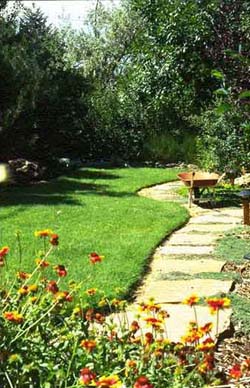How does kentucky bluegrass grow best?
Typical Kentucky bluegrass, the type of lawn most commonly grown here, grows best on 1.5” of supplemental water per week when the temperature is over 85 degrees. That means you will need to apply around an additional 15 inches of water a year to successfully grow your bluegrass lawn. Such use places a high demand on water – a limited resource vital to Colorado.
What benefits do lawns bring?
 Lawns offer many benefits and it makes sense to plant grass where it’s appropriate. Lawns anchor soil against wind and water erosion, and provide a safe surface on which children and adults can play and hold sporting events. Lawns also offer landscape variety when mixed with trees, shrubs and other plants.
Lawns offer many benefits and it makes sense to plant grass where it’s appropriate. Lawns anchor soil against wind and water erosion, and provide a safe surface on which children and adults can play and hold sporting events. Lawns also offer landscape variety when mixed with trees, shrubs and other plants.
When are lawns unsuitable?
However, in some situations, lawns simply aren’t practical. Lawns located on steep slopes or narrow strips, in the shade and in areas that receive heavy foot traffic are poor choices. Instead, consider terraced flower beds on slopes, ground cover plants in narrow strips and perennials or shrubs for shady areas, and a patio, flagstone path or sidewalk for heavily traveled areas.
What should I consider when planting a lawn?
Where lawns are appropriate, consider a grass that grows in xeric conditions. Water-thrifty buffalo grass works well in out-of-the-way expanse of a property. Dark green turf-type tall fescue grows deep roots and requires less irrigation when planted on well-prepared soils. Tall fescue also tolerates wear and tear from children playing. In the right location, buffalo grass and turf-type tall fescue will beautify any landscape.
Even drought tolerant grasses turn brown when they are not watered; they will turn green again when they receive water. The grass you choose for your Xeriscape turf area will depend on the amount of sunlight and the seasonal temperatures.
There are many different Xeriscape (hardscape) choices that are not attractive and lower maintenance. If you want the area to have a cool green look, other ground cover plants that use less water may be appropriate.
Beds of bark, stone or gravel mulch can be used as paths or edge of a driveway. Decks and patios increase outdoor living space while reducing lawn size.
Potted plant material can be used on hardscape areas to add color and it’s easy to hand water.
For more information, see the following Colorado State University Extension fact sheet(s).



